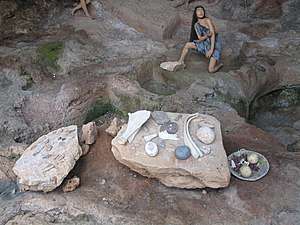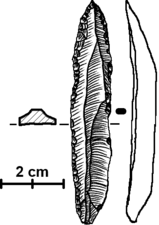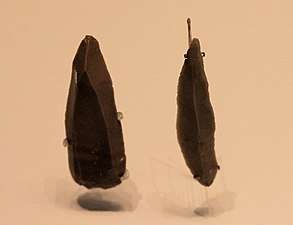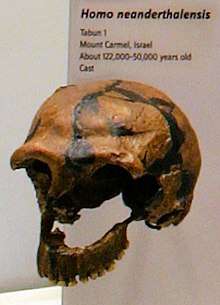Nahal Me'arot Nature Reserve
The Caves of Nahal Me’arot / Wadi el-Mughara ("Caves Creek"), named here by the Hebrew and Arabic name of the valley where they are located, are a UNESCO Site of Human Evolution in the Carmel mountain range near Haifa in northern Israel.[1][2]
| UNESCO World Heritage Site | |
|---|---|
 | |
| Official name | Sites of Human Evolution at Mount Carmel: The Nahal Me’arot / Wadi el‑Mughara Caves |
| Location | Mount Carmel, Israel |
| Criteria | Cultural: (iii), (v) |
| Reference | 1393 |
| Inscription | 2012 (36th session) |
| Area | 54 ha (130 acres) |
| Buffer zone | 370 ha (910 acres) |
| Coordinates | 32°40′12″N 34°57′55″E |
 Location of Nahal Me'arot Nature Reserve in Near East  Nahal Me'arot Nature Reserve (Israel) | |
The four UNESCO-listed caves are:
- Tabun Cave or Tanur Cave (lit.: "Oven")
- Gamal Cave or el-Jamal ("Camel")
- el-Wad Cave or Nahal Cave ("Stream")
- Es-Skhul Cave or Gedi Cave ("Kid")
The four caves were proclaimed a site of "outstanding universal value" by UNESCO[1] in 2012. They are protected within a nature reserve.[2]
The caves were used for habitation by hominins and prehistoric humans and contain unique evidence of very early burials, at the archaeological site of el-Wad Cave in the Nahal Me'arot Nature Reserve.
- A Paleolithic reconstitution in Jamal Cave
 Paleolithic tools in Jamal Cave (replica)
Paleolithic tools in Jamal Cave (replica)- Entrance to el‑Wad Cave
.jpg) Inside el‑Wad Cave
Inside el‑Wad Cave- Excavation work in el‑Wad Cave's terrace
 El‑Wad point microlith
El‑Wad point microlith

References
- UNESCO website
- "Nahal Me'arot Nature Reserve". Israel Nature and Parks Authority. Retrieved 31 December 2019.
External links
| Wikimedia Commons has media related to Nahal Mearot. |
- Official page at Israel Nature and Parks Authority website
- UNESCO: Sites of Human Evolution at Mount Carmel: The Nahal Me’arot / Wadi el-Mughara Caves
- Nahal Me'arot recognized as World Heritage Site
This article is issued from Wikipedia. The text is licensed under Creative Commons - Attribution - Sharealike. Additional terms may apply for the media files.